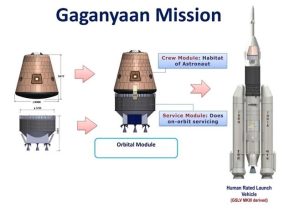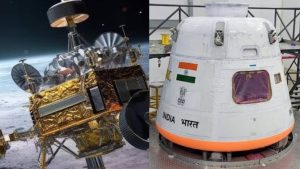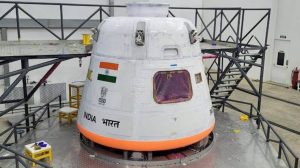Digital News Desk:
India’s space agency, the Indian Space Research Organisation (ISRO), recently announced two groundbreaking missions: the Gaganyaan human spaceflight mission set for 2026 and Chandrayaan-4, a follow-up lunar mission, likely scheduled for 2028. These missions underscore ISRO’s dedication to advancing space exploration and expanding India’s influence in the global space sector. Both missions mark an exciting era for India’s space endeavors, with Gaganyaan aiming to propel India into the realm of human spaceflight and Chandrayaan-4 deepening lunar exploration.
ISRO’s Trajectory of Success and Gaganyaan’s Promise
ISRO has established itself as a formidable player in space technology, most notably with its success in the Chandrayaan-3 mission, which made India the first nation to land a spacecraft near the Moon’s elusive south pole. Following Chandrayaan-3’s triumph, the agency is now channeling its efforts into more ambitious missions, with Gaganyaan leading the charge.
The Gaganyaan Mission: India’s Human Spaceflight Milestone
The Gaganyaan mission, India’s first manned space expedition, is one of the agency’s most ambitious projects to date. Initially scheduled for 2022, the timeline was pushed to 2026 due to the complexities involved in human spaceflight and the need for additional preparatory tests. Gaganyaan aims to send a three-member crew, termed “vyomanauts” (derived from the Sanskrit word “vyoma” for space), into low Earth orbit for a duration of approximately seven days.
ISRO’s preparation for Gaganyaan includes rigorous training for the crew, covering areas such as spacecraft operations, emergency protocols, and survival techniques under zero-gravity conditions. The mission is bolstered by various international collaborations, with support from Russia and France. The Russian space agency Roscosmos has assisted with astronaut training, while the French space agency CNES has contributed to safety systems and mission support infrastructure.

As a critical part of its planning, ISRO has been testing Gaganyaan’s crew escape system, designed to ensure astronaut safety by ejecting the crew safely in the event of an emergency during launch. In early 2024, ISRO conducted successful tests of the escape system and parachute deployment—milestones that indicate steady progress toward the 2026 launch.
The successful completion of Gaganyaan would mark India as the fourth nation to achieve human spaceflight, following in the footsteps of the United States, Russia, and China. This achievement holds immense significance for India’s space program, not only in terms of technical accomplishment but also for its global stature as a key player in human space exploration.
Chandrayaan-4: A Next-Level Lunar Exploration Mission
After the global acclaim of Chandrayaan-3, which successfully landed on the Moon in 2023, ISRO has laid out plans for Chandrayaan-4, targeting a 2028 launch. While Chandrayaan-3 focused primarily on landing technology and surface exploration near the lunar south pole, Chandrayaan-4 aims to expand scientific exploration. It will likely include more advanced landers and rovers, equipped with high-precision sensors and instruments to conduct in-depth studies of lunar geology, particularly focusing on water ice deposits thought to exist in the permanently shadowed regions near the poles.
The findings from Chandrayaan-4 could have profound implications for future space missions. Water ice on the Moon has potential uses in sustainable lunar exploration by providing a resource that could be converted into drinking water, breathable oxygen, and even rocket fuel. As international space agencies, including NASA and ESA, turn their focus to the Moon as a base for future missions, Chandrayaan-4’s data could contribute valuable insights that shape humanity’s long-term plans for the Moon.
ISRO has indicated that Chandrayaan-4 will be an international mission, possibly with collaborations from other space agencies. By aligning its mission objectives with those of programs like NASA’s Artemis, which aims to establish a long-term human presence on the Moon, ISRO contributes to a broader, collaborative vision of space exploration.
The Economic and Technological Impact of ISRO’s Missions
Beyond scientific discovery, ISRO’s upcoming missions will have substantial economic and technological impacts on India’s burgeoning space sector. Gaganyaan, for instance, has already driven advancements in areas like robotics, life-support systems, materials science, and human health monitoring. By pushing the limits of India’s technological capabilities, Gaganyaan and Chandrayaan-4 provide a platform for innovation, job creation, and new commercial opportunities.

The Indian space sector has seen a notable increase in private sector involvement, driven in part by ISRO’s commercial arm, Antrix Corporation, and the recently established NewSpace India Ltd (NSIL). These organizations facilitate commercial space ventures, offering services like satellite launches, satellite data, and consultancy, especially to emerging economies. By attracting private investment and fostering an innovation ecosystem, ISRO’s high-profile missions are paving the way for India’s private space companies to enter the global arena and compete with established space enterprises.
India’s Rising Role in International Space Collaboration
The success of missions like Gaganyaan and Chandrayaan-4 will further India’s position as a valuable partner in the international space community. ISRO’s cost-effective yet high-impact approach has attracted the interest of several space-faring nations. Partnerships with agencies in the United States, France, Japan, and Russia have been instrumental in building critical components and systems for India’s missions, and India’s expertise in remote sensing and lunar exploration has added value to these collaborations.
Furthermore, ISRO’s expanding collaborative reach reflects a vision of space as a shared resource. By working together, nations not only pool resources and knowledge but also inspire trust and mutual understanding. ISRO’s collaboration on lunar and human space missions aligns with international goals for peaceful and sustainable space exploration, making it a respected partner among space agencies globally.

Challenges on the Path Ahead
Despite the excitement surrounding these missions, the journey to launch remains complex and fraught with challenges. Human spaceflight, in particular, presents risks, especially in life-support reliability, crew safety, and re-entry protocols. ISRO is tackling these by conducting meticulous tests and developing robust systems to ensure astronaut safety.
Funding is also a significant concern, as ISRO operates with a comparatively modest budget. However, the agency’s history of delivering impactful missions on constrained budgets demonstrates its capability to achieve exceptional results with limited resources. This efficiency, however, requires continual innovation and resourcefulness to ensure that budgetary limitations do not hinder mission success.
Conclusion: ISRO’s Vision of Space Exploration
With Gaganyaan and Chandrayaan-4 on the horizon, ISRO continues to demonstrate its commitment to pushing the boundaries of space exploration. These missions signal India’s growing ambitions in space science and its readiness to join the ranks of human space exploration nations. As ISRO leads the charge in sending Indian astronauts into space and probes deeper into lunar science, it embodies the spirit of space exploration as a pursuit of knowledge that benefits all humanity. Through collaboration, innovation, and a steadfast commitment to advancing science, ISRO’s future missions will shape a legacy of exploration that resonates both in India and across the globe.
You May Also Read: From Earth to Mars: How ISRO Put India on the Global Space Map








